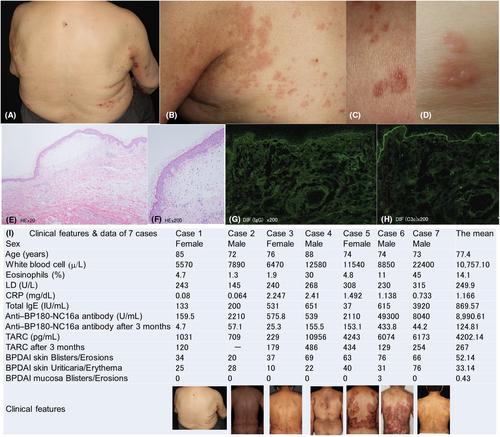大疱性类天疱疮1例与血清抗BP180 - NC16a抗体和胸腺及激活调节趋化因子水平相关
IF 0.9
Q4 ALLERGY
引用次数: 0
摘要
大疱性类天疱疮(BP)是一种自身免疫性起泡疾病,其特征是表皮下起泡和皮肤糜烂病变BP患者在表皮基底膜区产生针对BP180的NC16a结构域的自身抗体1,2。我们报告了一例BP与血清中抗bp180nc16a抗体和胸腺及激活调节趋化因子(TARC/CCL17)水平的相关性。病例1,一名85岁的日本女性,有5个月的红斑和瘙痒史,对局部类固醇治疗有耐药性。她有高血压和潜伏结核感染。体格检查显示身体、上臂、腿部和背部有红斑、糜烂和水疱(图1A - D)。皮肤水泡/糜烂的BP疾病面积指数(BPDAI)为34;皮肤荨麻疹/红斑的BPDAI为25。实验室检查结果如下(正常范围):白细胞计数:5570/μL (3300 ~ 8600 /μL);嗜酸性粒细胞4.7% (0.4% - 8.6%);乳酸脱氢酶(LD), 243 U/L (124 ~ 222 U/L);活性蛋白(CRP), 0.08 mg/dL (0.00 - 0.14 mg/dL);总免疫球蛋白E (IgE)为133.0 IU/mL (0 ~ 232 IU/mL)。血清抗bp180nc16a抗体滴度159.5 U/mL (0 ~ 8.9 U/mL), TARC水平升高1031 pg/mL (0 ~ 450 pg/mL)。右背部活检标本显示表皮下水疱(图1E,F)。直接免疫荧光显示IgG和C3c在表皮基底膜区呈线性沉积(图1G,H)。诊断为BP。开始口服强的松龙0.5 mg/kg/天可减轻皮肤症状。3个月后,BPDAI清晰,实验室检查结果有所改善:白细胞计数10,920/μL;嗜酸性粒细胞,0.2%;Ld, 293 u / l;CRP, 0.05 mg/dL;总IgE 14.9 IU/mL;抗bp180nc16a抗体滴度,4.7 U/mL;TARC, 120 pg/mL。为了探讨抗bp180nc16a抗体滴度与其他实验室数据的相关性,我们对7例到广明大学医院就诊的BP患者进行了评估。实验室数据从口服强的松龙治疗前的医疗记录中检索。根据临床、病理及免疫荧光特征诊断为BP。该研究已获得弘崎大学医学研究生院医学伦理委员会批准(No. 2021025)。在262例BP或可能BP患者中,检测TARC和抗bp180抗体(NC16a), 7例患者的抗bp180抗体(NC16a)呈阳性(图1I)。抗bp180nc16a抗体滴度平均为8990.61 U/mL,治疗3个月后抗体滴度提高至124.81 U/mL。平均TARC为4202.14 pg/mL,治疗3个月后改善为267 pg/mL。由于病例数少,我们无法显示统计学意义;治疗后,抗bp180nc16a抗体滴度和TARC平均值均下降。BP疾病活动性与抗bp180nc16a抗体滴度之间的相关性是众所周知的。BP与TARC之间的关系已有报道。3,4因此,TARC可能是参与BP发病的重要趋化因子。3,4我们推测TARC与抗bp180nc16a抗体滴度类似,可用于预测BP患者的临床状况。本文章由计算机程序翻译,如有差异,请以英文原文为准。

A case of bullous pemphigoid with correlation to serum levels of anti-BP180-NC16a antibodies and thymus and activation-regulated chemokine
Our cases suggest that thymus and activation-regulated chemokine (TARC) levels are correlated with bullous pemphigoid (BP) disease area index for skin uriticaria/erythema, and serum anti-BP180-NC16a antibody titers in patients with BP. TARC might be an important chemokine involved in the pathogenesis of BP (Br J Dermatol 2003;148:203; J Eur Acad Dermatol Venereol 2021;35:e121). We speculate that TARC is useful for predicting the clinical condition of patients with BP, similar to anti-BP180-NC16a antibody titers.
求助全文
通过发布文献求助,成功后即可免费获取论文全文。
去求助
来源期刊

Journal of Cutaneous Immunology and Allergy
Medicine-Dermatology
CiteScore
0.60
自引率
10.00%
发文量
69
审稿时长
12 weeks
 求助内容:
求助内容: 应助结果提醒方式:
应助结果提醒方式:


